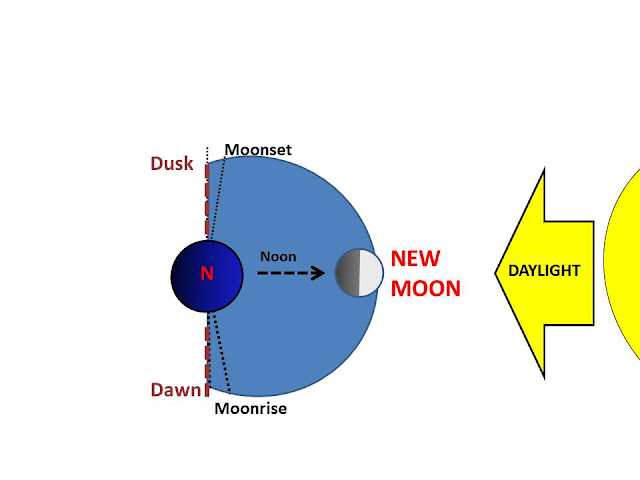A free post! Since I miscounted in the original series, and skipped #90, here's an informational post which isn't part of the 365 Days series. I wanted to help some friends understand why the different phases of the moon appear in the sky at different times during the day, so I put together a photo essay explaining it. That essay is below. Enjoy!
Looking down from above the north pole, Earth rotates counterclockwise, and the Moon orbits counterclockwise around the planet. The maroon lines mark sunrise and sunset in the earth's rotation, and the eight major phases of the moon are represented.
Like
Comment
Share
Same drawing, showing the times in earth's day where each phase of the moon is directly overhead in the sky, or at its "zenith".
Focusing on the "new moon", where we see no moon at all in the sky, because its reflective side is away from Earth, and the moon is overhead during daylight, when the Sun's light obscures both moon and stars. The new moon rises (invisibly to us) around dawn, and sets around dusk.
The waxing crescent, where only the right edge of the visible moon reflects sunlight. It rises in midmorning, is at its zenith in the afternoon, and sets in the evening.
The waxing half moon. Its right half visible to us reflects sunlight. It rises around noon, is at its zenith around sunset, and sets around midnight.
Waxing gibbous (hard "g", meaning rounded, derived from Latin "gibbus", hunchbacked). Most of the side visible to us, from the right edge over, reflects sunlight. It rises in the afternoon, is at its zenith before midnight, and sets in the predawn.
Full moon. We see the full reflective side. It rises around sunset, is at its zenith around midnight, and sets around dawn.
Waning gibbous. From the left edge past its midpoint we see its reflective side. It rises before midnight, is at zenith in the predawn, and sets in the morning.
Waning half, with the left half reflective and visible. It rises around midnight, is at zenith around dawn, and sets around noon.
Waning crescent. A reflective sliver on the left side is visible. It rises in the predawn, is at its zenith in the morning, and sets in the afternoon.
The Earth orbits the Sun on a flat plane called the ecliptic. The Moon orbits the Earth on another flat plane called the lunar ecliptic. But the two ecliptics are at an angle from one another, meaning even a new moon, in the sky during the day, rarely comes directly between the Earth and Sun.
When the lunar ecliptic does cross the Earth's, and the Moon does block some sunlight, it is too small to shroud the whole planet in shadow. The Moon fully blocks the Sun--achieves total eclipse--only for a small portion of the Earth's surface. It partially blocks--a partial eclipse--the light for a much greater portion of the Earth.
Likewise, occasionally the Earth blocks sunlight from the Moon (generally for the whole moon).
An easy trick to remind yourself where in the cycle the Moon's current phase is.
Also why harvest moons seem a little bigger: the refraction magnifies the moon a bit.



















No comments:
Post a Comment